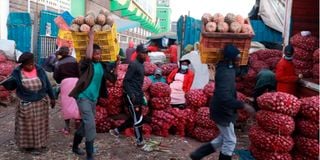Issues Ruto must balance with his promises to ‘hustlers’

Traders selling their produce at Marikiti Market on January 29, 2021. President-elect William Ruto's ultimate test will be how to balance the pledges with the economic reality in Kenya, choked by a high cost of living, the national debt, a tight budget and a battered economy
What you need to know:
- The ultimate test will be how to balance the pledges with the economic reality in Kenya, choked by a high cost of living, the national debt, a tight budget and a battered economy.
- Top on his to-do list Dr Ruto will be dealing with rising commodity prices that pushed the inflation rate to 8.5 per cent by August.
- This puts the cost of living among the top issues Dr Ruto must deal with to appease poor Kenyans on whose needs he successfully campaigned for the presidency.
His win in the August 9 presidential election affirmed by the Supreme Court, President-elect William Ruto must now deliver on promises he made to Kenyans.
But the ultimate test will be how to balance the pledges with the economic reality in Kenya, choked by a high cost of living, the national debt, a tight budget and a battered economy.
Top on his to-do list Dr Ruto will be dealing with rising commodity prices that pushed the inflation rate to 8.5 per cent by August, the highest level in five years, worsening the cost of living for citizens.
While the President-elect criticised the government for high food prices, high cost of inputs and other commodities just weeks ago, the big test for him now will be to deploy his strategies to bring down prices.
That includes the cost of maize flour, which is still retailing at over Sh200 and which his manifesto addressed.
High prices
He will have to address these prices while also considering the internal and external factors that have kept the prices high.
The Kenya National Bureau of Statistics (KNBS) last week reported that Kenyans endured one of the most difficult months in a decade last month, as rent and the prices of food, water, electricity, gas, detergent and other household commodities rose by up to 38 per cent compared with last year.
The price of maize flour, for instance, increased by 38 per cent in August compared with the same month last year, maize by 36 per cent, soap by 36 per cent, kerosene by 30 per cent, sugar by 23 per cent and rice by 16.5 per cent.
This puts the cost of living among the top issues Dr Ruto must deal with to appease poor Kenyans on whose needs he successfully campaigned for the presidency.

Traders invade pathways along the Marikiti market area on May 5, 2021, in Mombasa County.
And while he strives to control the cost of living, the President-elect will be balancing the measures he takes with government plans already underway.
Excise duty adjustment
The Kenya Revenue Authority (KRA) has proposed a 6.3 per cent excise duty adjustment on products including fuel, motorcycles, alcohol and SIM cards to align it with the inflation witnessed this year.
“In exercise of the powers conferred by Section 10 of the Excise Duty Act, 2015, the Commissioner-General adjusts for inflation the specific rates of duty set out in the Schedule hereto in accordance with the formula specified in Part 1 of the First Schedule to the Act with effect from October 1, 2022, and takes into account the average inflation rate for the 2021/2022 financial year of 6.3 per cent,” KRA Commissioner-General Githii Mburu stated in a public notice last week.
Since February, Kenya’s inflation has risen from 5.08 per cent, crossed the Central Bank of Kenya’s (CBK) red mark of 7.5 per cent in June (7.91 per cent), and hit 8.53 per cent in August.
The KRA measures will not only raise product prices but also take effect at just the time the Treasury plans to end the fuel subsidy programme that has prevented prices from rising to unprecedented levels. The Treasury’s move is intended to meet an International Monetary Fund (IMF) condition for allowing Kenya to access its loans.
“The authorities (Kenyan government) intend to continue gradually realigning domestic to global fuel prices in FY2022/23 so as to eliminate the fuel subsidy by October 2022,” an IMF report stated in July.
Going by the latest review of fuel prices by the Energy and Petroleum Regulatory Authority (Epra) for the period between August 15 and September 14, if the subsidy is eliminated, fuel prices will retail at highs of Sh215 (super petrol), Sh206 (diesel) and Sh202 (kerosene).
Fuel prices impact commodity prices because of their reliance on it for transportation and manufacturing and thus its cost is largely reflected in the cost of living, meaning the government will have to control fuel prices if it intends to keep the cost of living in check.
But the fuel subsidy is also an expense for the government, which runs on a deficit, seeking every coin it can get to pay debts and settle recurrent expenditures.
Kenya, in the first half of 2022 spent Sh71.2 billion on the fuel subsidy, reflecting a monthly average of Sh11.8 billion.
Fiscal position
The other headache for Dr Ruto will be implementing some of the promises he made to voters while balancing them with the reality of existing government plans and the fiscal position.
For instance, in his manifesto, Dr Ruto promised to bridge the current teacher shortage of 116,000 within two financial years and establish a one-year paid national internship programme for all students graduating from teachers, technical and medical colleges and universities.
He also pledged to double the amount of money allocated to the school feeding programme to feed four million children. But the current budget for the education sector in the 2022/23 budget is Sh513.8 billion, which has not been factored in his promise.
Dr Ruto also promised to allocate Sh250 billion in 2023-2027 to agriculture, with an annual amount slightly above the current budget’s Sh46.8 billion allocation to food and nutrition security.
“At a time when the price of Unga has hit an unprecedented Sh230, the role of agriculture [in] the cost of living need not be belaboured,” Dr Ruto said in his manifesto.
“Food accounts for 54 per cent of household expenditures, but the poor spend 60 per cent or more. Agricultural productivity has not kept up with population growth, resulting in higher dependence on food imports.”
The President-elect also promised to nearly double allocations to housing from President Kenyatta’s allocation of Sh27.7 billion for 2022/23 to Sh50 billion annually to boost rural and urban housing settlement.
Another promise Dr Ruto made was to make the National Hospital Insurance Fund (NHIF) accessible to all Kenyans, including paying for the contributions of those who cannot afford premiums, meaning an extra expense for his government.
To match all his promises with the current budget and fiscal situation, Dr Ruto may have to come up with a supplementary budget to re-channel funds to his priorities.
In contrast, other promises will face the reality of existing tax laws and external shocks such as a weak currency that has raised the cost of imports.
The weak shilling has also worsened Kenya’s debt position, increasing the external public debt by nearly Sh500 billion in the year to June, as it depreciated from exchanging at Sh107.85 units to the dollar to Sh117.83.
“The increase in the public debt is attributed to external loan disbursements, exchange rate fluctuation and the uptake of domestic debt during the period,” the Treasury stated in the 2021/22 quarterly budget and economic review report.
As the public debt grows, so has the cost of debt servicing for the government, with the nine months to March 2022 bringing such costs to a total of Sh651.7 billion, including 65.2 per cent of the amount in interest alone.
Dr Ruto also faces pending bills of Sh504 billion as of June 2022, largely borne by state corporations that are unable to pay contractors and suppliers.
“To remove [the] pressure of settling pending bills from the annual budget allocations, a transactions advisor will be engaged to advise on the securitisation of the outstanding bills subject to verification,” he promised in his manifesto.





